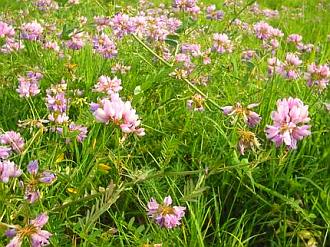Stringhalt
by Debora Johnson
Video by: Adria Halstead-Johnson/Green Mountain Curlies, Inc.
What is stringhalt? Have you ever seen a horse with stringhalt? What are the symptoms of stringhalt? Is it easily identifiable in a horse? Is it anything like hitching or stifle problems?
Symptoms
There are two types of stringhalt. "'Australian' stringhalt usually is a temporary disease resulting from toxicity, whereas 'classic' (or atypical, depending on the geographic region) stringhalt has no known cause and usually does not resolve on its own." Stringhalt in Horses  Stringhalt makes a horse look like it has an exaggerated gait when moving. It can be present in both hocks or only in one hock. There is a jerking of the hind leg or legs when they are flexed in an upward motion. Sometimes the stringhalt is so bad that the horse's hind leg looks like it is springing upward violently toward the horse's belly. Stringhalt can also interfere with the forward movement of a horse. Often a horse with stringhalt has great difficulty backing or cannot back at all. A horse with stringhalt will also have trouble taking tight turns. This is an abnormal condition that generally is associated with nerve damage. It should be noted that It is not usually seen in foals. Also, there does not seem to be a breed or gender predisposition to stringhalt. It should also be noted that are varying degrees of stringhalt from mild to severe. Stringhalt makes a horse look like it has an exaggerated gait when moving. It can be present in both hocks or only in one hock. There is a jerking of the hind leg or legs when they are flexed in an upward motion. Sometimes the stringhalt is so bad that the horse's hind leg looks like it is springing upward violently toward the horse's belly. Stringhalt can also interfere with the forward movement of a horse. Often a horse with stringhalt has great difficulty backing or cannot back at all. A horse with stringhalt will also have trouble taking tight turns. This is an abnormal condition that generally is associated with nerve damage. It should be noted that It is not usually seen in foals. Also, there does not seem to be a breed or gender predisposition to stringhalt. It should also be noted that are varying degrees of stringhalt from mild to severe.
What Causes Stringhalt?
The exact cause of stringhalt is not known, however, there are some plants that can cause nerve degeneration: flatweed (Hypochoeris Radicata), lathyrism, vetch, sweet peas and dandelion  are among these plants. Also trauma can cause stringhalt. are among these plants. Also trauma can cause stringhalt.

Hypochoeris Radicata/Factsheet 
A toxic plant in the family Asteraceae; contains an unidentified toxin; probably causes Australian stringhalt. Called also flatweed, catsear. The Free Dictionary by Farlex 

Vetch  The vetches grown as forage are generally toxic to non-ruminants (such as humans), at least if eaten in quantity. Cattle and horses have been poisoned by V. villosa and V. benghalensis, two species that contain canavanine in their seeds. Canavanine, a toxic analogue of the amino acid arginine, has been identified in Hairy Vetch as an appetite suppressant for monogastric animals, while Narbon Bean contains the quicker-acting but weaker ?-glutamyl-S-ethenylcysteine. Vetch The vetches grown as forage are generally toxic to non-ruminants (such as humans), at least if eaten in quantity. Cattle and horses have been poisoned by V. villosa and V. benghalensis, two species that contain canavanine in their seeds. Canavanine, a toxic analogue of the amino acid arginine, has been identified in Hairy Vetch as an appetite suppressant for monogastric animals, while Narbon Bean contains the quicker-acting but weaker ?-glutamyl-S-ethenylcysteine. Vetch  The invasion of Crown Vetch The invasion of Crown Vetch  Crown vetch is toxic to horses because of the presence of nitroglycosides. If consumed in large amounts, it can cause slow growth, paralysis, or even death. Crown vetch is toxic to horses because of the presence of nitroglycosides. If consumed in large amounts, it can cause slow growth, paralysis, or even death.

Sweet Pea is native to the eastern Mediterranean region from Sicily east to Crete. Unlike most peas, the seeds of the sweet pea are poisonous. The seeds contain a neurotoxin, and should not be eaten. The illness caused by the ingestion of sweet peas is known as odoratism, or sweet pea lthyrism. Poisonous Plants on the Planet 
Treatment
It is important to keep a horse with stringhalt calm. Surgery can be done on the hock tendons and parts of the muscle Thiamine and phenytoin are given. Some horses respond to treatment, however, many do not.
Diseases and Conditions With Similar Symptoms
There are several other diseases and conditions that will mimic stringhalt: Among them are peripheral neuropathy (nerve generation), equine protozoal myelitis (EPM), stifle problems (upward fixation of the patella), shivers and fibrotic myopathy.  (In fibrotic myopathy, the affected limb is pulled back and down before the end of the protraction phase, resulting in a lengthened weightbearing phase and a shortened cranial phase. The signs are most obvious at the walk.)(In stringhalt, the affected limb is hyperflexed during the cranial or swing phase, while the stepwise caudal jerking movement before foot contact does not occur.) (In fibrotic myopathy, the affected limb is pulled back and down before the end of the protraction phase, resulting in a lengthened weightbearing phase and a shortened cranial phase. The signs are most obvious at the walk.)(In stringhalt, the affected limb is hyperflexed during the cranial or swing phase, while the stepwise caudal jerking movement before foot contact does not occur.)
For More Information:
The Vet Merck Manual/Stringhalt
Stringhalt in Horses 
|